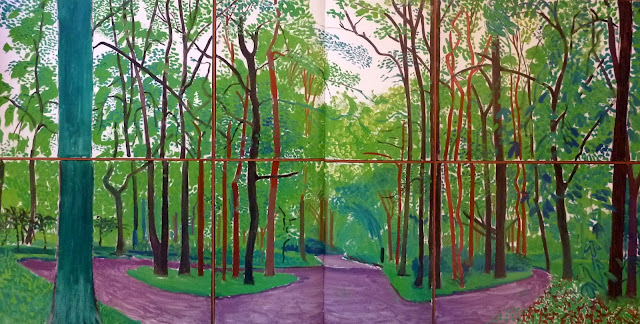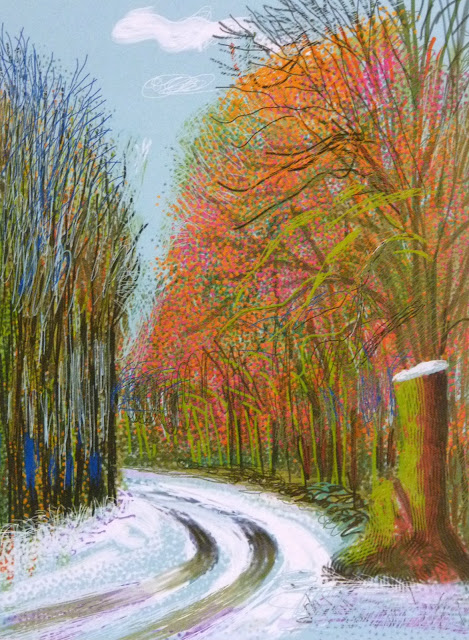David Hockney - A Bigger Picture, at the Royal Academy of Arts.
Another very late post of an exhibition I saw in April. Doing it this late though has given me the chance to revisit the exhibition, and to remind myself how breathtakingly beautiful these paintings are.
We were not allowed to photograph but even if we had, the number of people viewing the paintings would have made it impossible. These are photographs I took from the exhibition catalogue - there are far too many, but I did as much editing out as I could.
Some of these paintings are huge. They induce a sensation of awe. When David Hockney was invited to stage an exhibition in the whole space of the Royal Academy and having exhibited one very large painting which took up the whole of the west wall in Gallery Three, and realising that the walls of the Royal Academy were made for large paintings, he saw this as a challenge and immediately looked for a new studio that could accommodate the production of a 'bigger picture'.
Returning to his native Yorkshire Hockney started painting the landscape he knew so well working in the open with intense dedication but also aware of the role of memory because 'one looks with memory even when intent on documenting the moment'. What does he mean by memory? First of all memory as constituted by personal associations with particular places. But also, the resonances of a particular topography in local and national history. Finally, and as important, the deeply ingrained memory of artistic traditions, the ability to see the landscape refracted through the accumulated work of countless generations of earlier artists.
He often quotes two Chinese adages: that painting is an old person's art and, even more importantly, that to make a successful painting three things are necessary: the eye, the heart and the hand. Two won't do.
So, we see the influence of the Impressionists and Post-Impressionists on Hockney's latest work: not just the unapologetic prettiness of their paintings, or their celebration of the beauty of nature, but also the vivid colours employed by the Fauve painters. The biggest influence however is Monet, not just because of the immediacy of his technique in working out of doors, but also in his use of serial imagery: returning in different weather conditions and in different times of the day to the same motifs, as well as in the enveloping scale of his late panoramic paintings of the water lillies in the ponds at his home at Giverny.
But, even though Hockney is in dialogue with the French Impressionist and the Fauve paintings, the subject, by contrast, is very English. There has been criticism that some of his most exuberant colours are not to be found under a pale Yorkshire winter sun. This is however in line with Impressionist colour theory which allowed Monet's haystacks to contain vivid hues of purple and red in order to capture prismatic effects of reflected light.
Earlier landscapes
Flight into Italy - Swiss Landscape, 1962
Ordinary Picture, 1964
Nichols Canyon, 1980
First Yorkshire Landscapes
The Road to York Through Sledmere, 1997
North Yorkshire, 1997
The Road across the Wolds, 1997
Garrowby Hill, 1998
Watercolours and First Oils from Observation
Untitled Harvest, 2005
Woldgate Vista, 27 July 2005
Langtoft to Kilham, 31 July 2005
Bugthorpe Valley, August 2005
Woldgate, 24 November 2005
Woldgate Mist, November, 2005
For this exhibition the curators decided to arrange the paintings by motif: Woldgate Woods, the tunnel, felled timber and totemic tree trunks, hawthorn blossoms, the three trees near Thixendale in each of the four seasons - all displayed in isolation from other groups, intensifying the sensation of being placed right inside each unique landscape. As you went from room to room you got a strong sense of what Hockney gained in returning repeatedly to certain places that he had got to know like old friends.
The Tunnel
An avenue of trees that Hockney has repeatedly painted - you get such a strong sense of the seasons and all of the changes associated with them.
The Tunnel, Early Autumn, October, 2005
Winter Tunnel, November 2006
Winter Tunnel with Snow, March 2006
Late Spring Tunnel, May 2006
Early July Tunnel, 2006

Tree Tunnel, August 2005
Early November Tunnel, 2006
Late November Tunnel, 2006
Woldgate Woods
Woldgate Woods, 20 and 21 May, 2006 (oil on six canvasses)
Woldgate Woods, 26, 27 and 39 July 2006 (oil on six canvasses)
Woldgate Woods, 24, 25 and 36 October 2006 (oil on six canvasses)
Woldgate Woods, 6 and 9 November 2006 (oil on six canvasses)
Woldgate Woods, 7 and 8 November, 2006 (oil on six canvasses)
Woldgate Woods, 21, 23 and 25 November 2006
Woldgate Woods, 4, 5 and 5 December 2006 (oil on six canvasses)
Miscellaneous
Looking East, 2006 (oil on canvas)
Woldgate, 24 November 2005, (oil on canvas)
Thixendale Trees - Bigger Trees
The changing seasons is so eloquently conveyed in these four paintings, the different qualities of light and atmosphere, the transformation of the trees themselves from the fullness of summer to the bare branches of winter.
Three Trees near Thixendale, Summer 2007 (oil on eight canvasses)
Three Trees near Thixendale, Autumn 2008 (oil on eight canvasses)
Three Trees in Thixendale, Winter 2007 (oil on eight canvasses)
Winter Timber and Totems
This series of paintings, more than any of the others, is a powerful acknowledgement of the natural cycle of life, decay and death. The vibrant colours of the winter landscapes do not disguise the sense of melancholy attached to the massive clump of trees, so stark in their winter bareness speaking of old age and isolation.
Felled Trees on Woldgate, 2008 (oil on two canvasses)
More Felled Trees on Woldgate, 2008 (oil on two canvasses)
Winter Timber, 2009 (oil on fifteen canvasses, each 91.4 x 121.9 cm)
The Sermon on the Mount
The Sermon on the Mount II (After Claude), 2010
Hockney painted several of these, based on
The Sermon on the Mount, by Claude Lorrain, in the Frick Collection, New York.
The Arrival of Spring in Woldgate, 2011 - using the iPad
'I had planned to record the spring ariving in 2011 having observed its arrival for seven years on Woldgate, a small single-track road that runs from Bridlington to Kilham, about ten miles... In winter in Woldgate the branches of trees seem to be stretching upwards, searching for nourishing light; at the end of summer they're weighed down, gravity doing work that the life force seemed to deny...
'When the snow came in late December 2010 I began to draw it on my iPad sitting in a car. I had the drawings printed out about five feet high. After making five or so like this, I began to realise that using the iPad could be a good method of recording all the changes that I knew would occur in this quiet road... You have to show the winter first, to appreciate how much evverything changes...
I calculated that I could show the change in Gallery Three with about 70 pictures, two rows of 35'.
Later he said: 'the iPad is becoming a fantastic tool for me... What is really good about it is its speed. No other medium using colour is as fast. You can get things down very fast, meaning you can capture quick lighting effects like nothing else. The spring is just spectacular this year and I am getting it down. The winter ones now look very wintry. I am very confident it will be one of my major works'.
1 January
8 January
29 January
19 March
30 March
12 April
More Recent Works
Under the Trees, Bigger, 2010-11, (oil on twenty canvasses, each 91.4 x 121.9 cm)
Under the Trees, Woldgate, 2010
Yosemite II, October 5th, 2011 (iPad drawing printed on six pieces of paper)
Films made with 9 and 18 cameras
A departure from the still photographic image into digital film-making with eighteen-screen installations of Woldgate and other country roads. Each half of the work was filmed simultaneously with nine cameras viewed by the artist on nine monitors as the vehicle was driven at very slow speed, and then further deccelerated in the editing process. These composite videos were breathtaking. The careful alignment of the cameras was a crucial factor for Hockney so that a coherent overall vista could be created.
'Why nine cameras? What can they do that one can't? Well, they can make a bigger picture for a start, a more intense picture for the viewer to scan. Different moments in time appear throughout, no longer just one...Having nine separate perspectives forces the eye to scam as it is impossible to see everything at once....
Using nine screens gives back the choice to the viewer, and hence, it seems to me, brings about possibilities for new narratives. Grandeur can be a subject again, having become more and more difficult with one camera. Film cameramen have always said it's difficult to film the tallness of trees - or for that matter the tallness of anything - because to show it all you have to be too far away. Put three cameras one above another and you can be a lot closer and the grandeur of the tree can become a subject; you feel more connected with what you are looking at'.
We all like to rant about our little obssessions, and this little plaque was on a coffee table in the atelier, and I guess, he could not help himself!
And a closer look. I thought it was hilarious...



























































A great report Eirene. I'm quite jealous really as I wasn't able to visit this exhibition.
ReplyDeleteHave you tried creating a picture on your ipad? He makes it look so easy! But it isn't.
It was a great exhibition and I enjoyed it immensely despite the crowds.
DeleteI cannot draw or paint at all, so have not tried creating a picture on the ipad. I know my limitations....
I tried to make a copy of one of the woldgate woods pictures on my iPad to see how he did it...astonishingly painstaking and time consuming and I made a reasonable stab at it but got so bored!!
ReplyDeleteImagination bring a new invention and great artist can change the value of waste things into a thought that everything is priceless compare this waste .............!
ReplyDeleteVery true. Thank you for your comment.
Delete